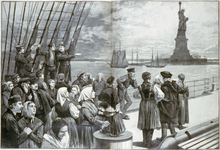This article is about objects used in navigation. For visitor attractions, see Tourist attraction. For other uses, see Landmark (disambiguation).
| This article needs additional citations for verification. Please help improve this article by adding citations to reliable sources. Unsourced material may be challenged and removed. Find sources: "Landmark" – news · newspapers · books · scholar · JSTOR (January 2016) (Learn how and when to remove this message) |

A landmark is a recognizable natural or artificial feature used for navigation, a feature that stands out from its near environment and is often visible from long distances.
In modern-day use, the term can also be applied to smaller structures or features that have become local or national symbols.
Etymology

In Old English, the word landmearc (from land + mearc (mark)) was used to describe a boundary marker, an "object set up to mark the boundaries of a kingdom, estate, etc." Starting around 1560, this interpretation of "landmark" was replaced by a more general one. A landmark became a "conspicuous object in a landscape".
A landmark literally meant a geographic feature used by explorers and others to find their way back to their departure point, or through an area. For example, Table Mountain near Cape Town, South Africa, was used as a landmark to help sailors navigate around the southern tip of Africa during the Age of Exploration. Artificial structures are also sometimes built to assist sailors in navigation. The Lighthouse of Alexandria and the Colossus of Rhodes are ancient structures built to lead ships to the port. In modern usage, a landmark includes anything that is easily recognizable, such as a monument, building, or other structure. In American English it is the main term used to designate places that might be of interest to tourists, due to notable physical features or historical significance. Landmarks in the British English sense are often used for casual navigation, such as giving directions. This is done in American English as well.
In urban studies as well as in geography, a landmark is furthermore defined as an external point of reference that helps orientation in a familiar or unfamiliar environment. Landmarks are often used in verbal route instructions ("Turn left at the big church and then right over the bridge.")
Types

Landmarks are usually classified as either natural landmarks or human-made landmarks, both are originally used to support navigation on finding directions. A variant is a seamark or daymark, a structure usually built intentionally to aid sailors navigating featureless coasts.
Natural
Natural landmarks can be characteristic features, such as mountains or plateaus. Examples of natural landmarks are Mount Everest in the Himalayas, Table Mountain in South Africa, Mount Ararat in Turkey, Uluru in Australia, Mount Fuji in Japan and the Grand Canyon in the United States. Trees might also serve as local landmarks, such as jubilee oaks or conifers. Some landmark trees may be named, such as Queen's Oak, Hanging Oak and Centennial Tree. Bases of fallen trees, known in this context as rootstocks, are used as navigational aids on high-resolution maps and in the sport of orienteering. Because most woods have many fallen trees, generally only very large rootstocks are mapped.
Human made
In the modern sense, landmarks are usually referred to as monuments or prominent distinctive buildings, used as the symbol of a certain area, city, or nation. Some examples are Tokyo Tower in Tokyo, the White House in Washington, D.C., the Statue of Liberty and Empire State Building in New York City, the Eiffel Tower in Paris, Saint Basil's Cathedral in Moscow, the Lotte World Tower in Seoul, the Colosseum in Rome, Big Ben in London, the Tsūtenkaku in Osaka, the Forbidden City in Beijing, the Great Pyramid in Giza, Christ the Redeemer in Rio de Janeiro, Statue of Unity in Narmada, Bratislava Castle in Bratislava, Helsinki Cathedral in Helsinki, the Space Needle in Seattle, the Sydney Opera House in Sydney, the Brandenburg Gate in Berlin, the Château Frontenac in Quebec (city), Place Stanislas in Nancy, the CN Tower in Toronto, the Palace of Culture and Science in Warsaw, the Atomium in Brussels, Gateway Arch in St Louis, and the Moai in Easter Island. Church spires and mosque minarets are often very tall and visible from many miles around and thus often serve as built landmarks. Also town hall towers and belfries often have a landmark character.
See also
- Boundary marker
- Contemporary history
- Cultural heritage management
- Cultural heritage tourism
- National landmark (disambiguation)
- National symbol
References
- "LANDMARK | meaning in the Cambridge English Dictionary". dictionary.cambridge.org. Retrieved 2 August 2020.
- "Online Etymology Dictionary". Etymonline.com. Retrieved 25 January 2016.
- "Landmarker".
- Lynch, Kevin. "The image of the city". MIT Press, 1960, p. 48
- International Specification for Control Descriptions. International Orienteering Federation. 2018.